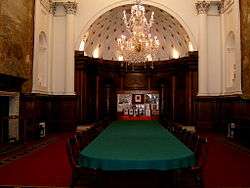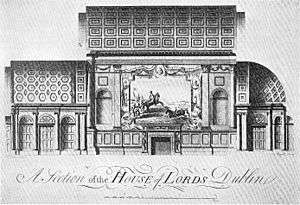Irish House of Lords
| Irish House of Lords | |
|---|---|
.svg.png) | |
| Type | |
| Type | |
| History | |
| Established | 1297 |
| Disbanded | 31 December 1800 |
| Succeeded by | House of Lords of the United Kingdom |
| Leadership | |
|
The Earl of Clare1 (1789–1801) | |
| Elections | |
| Appointment by monarch or inheritance of seat | |
| Meeting place | |
 | |
| Lords Chamber, Irish Houses of Parliament, Dublin | |
| Footnotes | |
|
1In 1800 See also: | |
The Irish House of Lords was the upper house of the Parliament of Ireland that existed from medieval times until 1800. It was modelled on the House of Lords of England, with members of the Peerage of Ireland sitting in the Irish Lords, just as members of the Peerage of England did at Westminster. When the Act of Union 1800 abolished the Irish parliament, a subset of Irish peers sat in the House of Lords of the merged Parliament of the United Kingdom.[1]
Function

The Parliament of Ireland was a bicameral legislature, and bills could originate in either the Commons or the Lords; both had to pass a bill for it to become law. Either house could amend or reject the others' proposals. Under Poynings' Law, bills passed by the Irish parliament had to be pre-approved by the Irish Privy Council and English Privy Council; debates before this approval were technically on "heads of bills", as the formal "bill" could only be rejected or passed unamended.
The Lords was the highest court of appeal in Ireland, as the English (later British) Lords were in England. However, the controversial British Declaratory Act of 1719 asserted the right of the British Lords to overrule the Irish Lords. The Irish Patriot Party secured the repeal of the Declaratory Act as part of the Constitution of 1782.
The House of Lords was presided over by the Lord Chancellor, who sat on the woolsack, a large seat stuffed with wool from each of the three lands of England, Ireland and Scotland. At the state opening of the Irish parliament Members of Parliament were summoned to the House of Lords from the House of Commons chamber by Black Rod, a royal official who would "command the members on behalf of His Excellency to attend him in the chamber of peers". Sessions were formally opened by the Speech from the Throne by the Lord Lieutenant, who sat on the throne beneath a canopy of crimson velvet.
Sessions were generally held at Dublin Castle in the 16th and 17th centuries, until the opening of the Irish Houses of Parliament in the 1730s.
History
The Lords started as a group of barons in the Lordship of Ireland that was generally limited to the Pale, a variable area around Dublin where English law was in effect, but did extend to the rest of Ireland. They sat as a group, not as a separate House, from the first meeting of the Parliament of Ireland in 1297. From the establishment of the Kingdom of Ireland in 1542 the Lords included a large number of new Gaelic and Norman lords under the policy of surrender and regrant.
Religious division was reflected in the House, but as late as the 1689 "Patriot Parliament" a majority of Lords had remained Roman Catholics, while the administration and a slight majority in the Commons were Church of England. By 1632 the (Catholic) Lord Baltimore established colonies in Newfoundland and Maryland. In 1634 the campaign to secure "The Graces" came to a head. Most of these Catholic lords lost their titles in the ensuing 1641 rebellion, notably during the 1652 Cromwellian Settlement. These dispossessed lords were regranted their titles (if not always their lands) after the Restoration of 1660 by the Act of Settlement 1662. Others took the losing side in the Williamite War in Ireland (1689–91), and a much smaller number of them were re-granted their lands in the 18th century.
By the 1790s most of the Lords personified and wanted to protect the "Protestant Ascendancy". By the time of its abolition in 1800 some of the peerages were very ancient, such as the lords Kingsale, created in 1397, and the viscounts Gormanston from 1478. The first Earl of Kildare had been created in 1316.
Following the Act of Union in 1800, the peerage of Ireland elected just 28 of their number to sit in the United Kingdom House of Lords, described as the "representative peers". This practice ended in 1922 with the establishment of the Irish Free State. Other newly created Irish peers, such as Clive of India and Lord Curzon, were able to stand for election to the UK House of Commons (not being UK Peers), without giving them a seat in the British House of Lords. This was a convenient way of giving a title for reasons of prestige to someone who expected to sit in the British House of Commons.[2]
Today the 18th century Irish Parliament building on College Green in Dublin is an office of the commercial Bank of Ireland and visitors can view the Irish House of Lords chamber within the building.
See also
Footnotes
- ↑ E.M. Johnson-Liik History of the Irish parliament in 6 vols. (Belfast, 2002).
- ↑ http://www.burkespeerage.com/articles/ireland/page93.aspx
External links
- Journals of the House of Lords
- Vol 1 Vol 2 Vol 3 Vol 4 Vol 5 Vol 6 Vol 7 Vol 8 Proceedings 1634–1800; printed 1779–1800; large (~1 GB) PDF files from the Oireachtas library